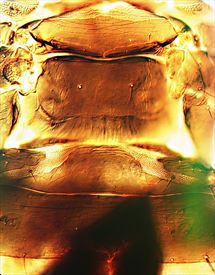Distinguishing features
Female fully winged (or micropterous). Body dark brown, darkest on head and tube; legs dark; extreme apices of femora and bases of tibiae yellow; fore tibiae yellowish-brown; all tarsi paler. Antennae variable, segments I and VI–VIII dark brown, II variably yellow at apex, III yellow with apex more or less brown; IV yellow in proximal half but sometimes pale brown; V with pedicel yellow or uniformly brown; major setae dark brown; fore wings dark at base, weakly shaded distally. Head almost as wide as long, longer than tube; compound eyes as large dorsally as ventrally; postocular setae shorter than distance between their bases; ocellar setae as long as distance between posterior ocelli, arising between them; maxillary stylets retracted halfway into head. Antennal segments III and IV subequal in length; segment III with 2 sense cones, IV with 4. Metanotum broad, with a reticulate pattern, and with 1 pair of setae medially. Fore tarsal tooth absent. Fore wings with 3 major sub-basal setae, S1 and S3 equal in length, with 5–11 duplicated wing cilia; micropterae with wing buds varying in length and bearing 2 long setae. Pelta broad, without small setae laterally on median lobe; tergites II–VII with curved or sigmoid wing-retaining setae; tergite IX posteromarginal setae more than half as long as tube; tube margins weakly convex in distal third.
Male microptera similar to female, but usually smaller; fore tarsal tooth present.
Related species
The genus Nesothrips includes 31 species, of which 6 are endemic to New Zealand, 13 are from Australia, 9 described from various Pacific islands, and 3 from southeast Asia. Nesothrips species usually have a rather short head, with a pair of setae between the hind ocelli, and the maxillary stylets wide apart. N. rangi is intermediate in structure between the forms with long or short heads, in that the head is relatively broad but the ocellar setae arise between the posterior ocelli.
Biological data
Spore-feeding at the base of tussocks of grasses or Juncus sp., and apparently associated with damp areas.
Distribution data
Known only from New Zealand (AK, BP / NN, MB, BR, CO, SL).
Family name
PHLAEOTHRIPIDAE, IDOLOTHRIPINAE
Species name
Nesothrips rangi Mound & Palmer
Original name and synonyms
Nesothrips rangi Mound & Palmer, 1983: 48
References
Mound LA & Palmer JM (1983) The generic and tribal classification of spore-feeding Thysanoptera (Phlaeothripidae: Idolothripinae). Bulletin of the British Museum (Natural History). Entomology 46: 1–174.
Mound LA & Walker AK (1986) Tubulifera (Insecta: Thysanoptera). Fauna of New Zealand 10: 1–140.


